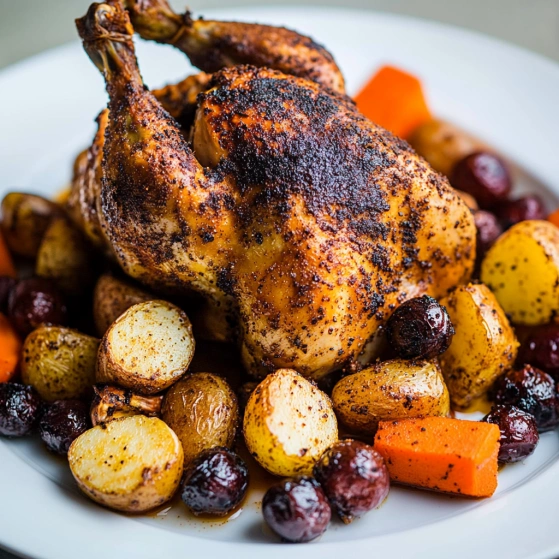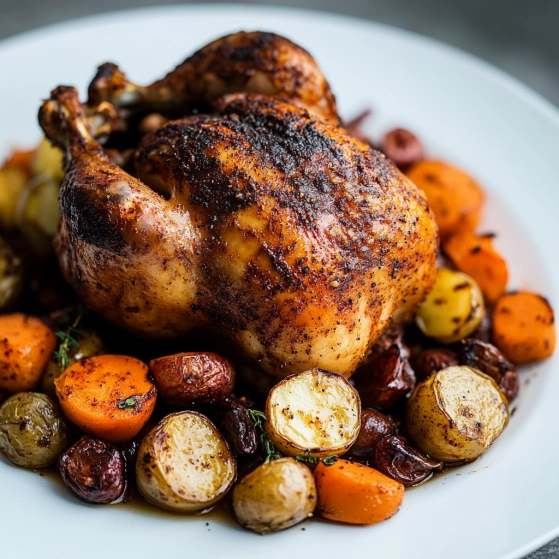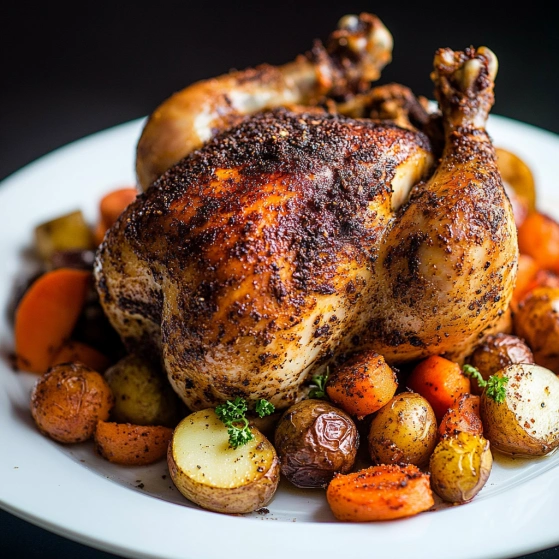 Pin it
Pin it
Roasting a whole chicken doesn't have to be complicated, and this Bundt Pan Chicken method proves it beautifully. The genius of this approach lies in how the Bundt pan elevates the chicken, allowing heat to circulate evenly while the vegetables roast beneath, absorbing all those delicious drippings. The result is perfectly cooked, juicy chicken with caramelized vegetables that have been infused with incredible flavor.
I tried this recipe last Sunday when my sister and her family came over unexpectedly. The presentation alone got everyone excited, and my brother-in-law—who typically goes for seconds of just the meat—couldn't stop eating the vegetables.
Ingredients
- 3-4 lb whole chicken: The star of the show—look for one with intact skin and no tears for the juiciest result. Farm-raised chickens typically offer better flavor.
- 1½ lbs baby potatoes: Yukon gold or red potatoes hold their shape well while absorbing flavor. Choose uniform sizes or halve larger ones for even cooking.
- 1 yellow onion: Provides sweetness as it caramelizes. Select firm onions without soft spots.
- 1 lb carrots: Adds color and natural sweetness. Choose bright, firm carrots without cracks.
- 2 tablespoons extra virgin olive oil: Helps crisp the chicken skin and coat the vegetables. A good quality oil makes a difference.
- 2 teaspoons salt: Enhances all flavors—kosher salt works best for even distribution.
- Spice blend (onion powder, paprika, black pepper, garlic powder, dried thyme): This combination creates depth without overpowering the natural flavors.
Cooking Instructions
- Step 1:
- Set your oven to 425°F and allow it to fully preheat. This high temperature is crucial for crispy chicken skin and caramelized vegetables. While waiting, thoroughly grease a 12-cup Bundt pan with cooking spray or butter, making sure to get into all the crevices to prevent sticking. Then take a small piece of aluminum foil (about 5x5 inches), fold it a few times, and place it over the center hole of the Bundt pan to prevent drippings from leaking through.
- Step 2:
- Combine your halved baby potatoes, onion wedges, and chopped carrots in the prepared Bundt pan. Drizzle with 1 tablespoon of olive oil, making sure to toss them gently so all pieces get a light coating. This oil helps the vegetables roast rather than steam and assists in browning.
- Step 3:
- In a small bowl, combine the salt, onion powder, paprika, black pepper, garlic powder, and dried thyme, stirring well to create a uniform seasoning mixture. Sprinkle about half of this mixture over your vegetables in the Bundt pan, then toss again to ensure even distribution of the spices throughout.
- Step 4:
- Pat your chicken completely dry with paper towels—this is essential for crispy skin. Drizzle the remaining tablespoon of olive oil over the entire chicken, using your hands to rub it all over the skin. Then apply the remaining seasoning mixture, taking time to rub it under the skin where possible and inside the cavity for maximum flavor penetration.
- Step 5:
- Position the chicken cavity over the center hole of the Bundt pan, pressing down gently so it sits securely. The chicken should stand upright with the legs pointing up. Place the entire pan in the preheated oven and bake for 60-70 minutes, or until a meat thermometer inserted into the thickest part of the thigh registers 165°F. The skin should be golden brown and crispy.
- Step 6:
- Once done, remove from the oven and let everything rest for 15 minutes before attempting to move or carve the chicken. This resting period allows the juices to redistribute throughout the meat, ensuring maximum moisture retention. Use this time to transfer the vegetables to a serving dish if desired.
 Pin it
Pin it
My grandmother always said chicken drippings were "liquid gold" in cooking, and this recipe proves her right. My kids usually push carrots around their plates, but when they're roasted under chicken this way, soaking up all those savory juices, even my pickiest nine-year-old asks for seconds.
Perfect Timing Matters
The success of Bundt pan chicken relies heavily on timing and temperature. Cooking at 425°F creates the perfect environment for rendering fat while crisping the skin. If the temperature is too low, you'll end up with flabby skin and undercooked vegetables. Too high, and the exterior will burn before the interior reaches a safe temperature. I've found that checking the chicken at the 50-minute mark gives you a good indication of how much longer it needs—if the skin is already deeply golden, you might want to tent it loosely with foil to prevent burning while the meat finishes cooking.
Seasonal Vegetable Variations
Don't feel limited by the classic potato-carrot-onion combination. This cooking method works beautifully with seasonal adaptations. In summer, try adding chunks of zucchini, bell peppers, or cherry tomatoes during the last 30 minutes of cooking to prevent them from becoming too soft. Fall brings opportunities for butternut squash, Brussels sprouts, and parsnips, which all caramelize beautifully under the chicken. Winter calls for heartier options like turnips, rutabaga, or sweet potatoes that can withstand the full cooking time and soak up those rich drippings. The key is adjusting cooking times for more delicate vegetables and cutting everything to similar sizes for even cooking.
 Pin it
Pin it
Leftovers Transformation
The beauty of this dish extends well beyond your first meal. Leftover Bundt pan chicken and vegetables can transform into entirely new dishes with minimal effort. Shred remaining chicken and combine with the vegetables to create a hearty soup by adding broth and herbs. For a quick lunch, toss the chopped leftovers with greens, a simple vinaigrette, and some toasted nuts for a satisfying salad. Perhaps my favorite repurposing technique is creating a pot pie—simply chop everything smaller, add a creamy sauce, and top with store-bought puff pastry for a completely different dinner experience the next day. Even the chicken carcass shouldn't go to waste—it makes an exceptionally flavorful stock that becomes the foundation for future soups and sauces.
Frequently Asked Questions
- → Why use a bundt pan for chicken?
A bundt pan allows for even heat circulation, ensuring the chicken cooks evenly and achieves a crispy exterior while keeping juices intact.
- → Can I use different vegetables?
Yes, you can swap or add vegetables like sweet potatoes, parsnips, or celery to suit your preference.
- → How do I know when the chicken is cooked?
The chicken is ready when the thickest part reaches an internal temperature of 165°F. Use a meat thermometer for accuracy.
- → Should I cover the chicken while roasting?
No, leaving the chicken uncovered allows the skin to crisp up and develop a golden-brown color.
- → What can I do with pan drippings?
Use the drippings to make a flavorful gravy, or drizzle them over the roasted veggies for extra flavor.
